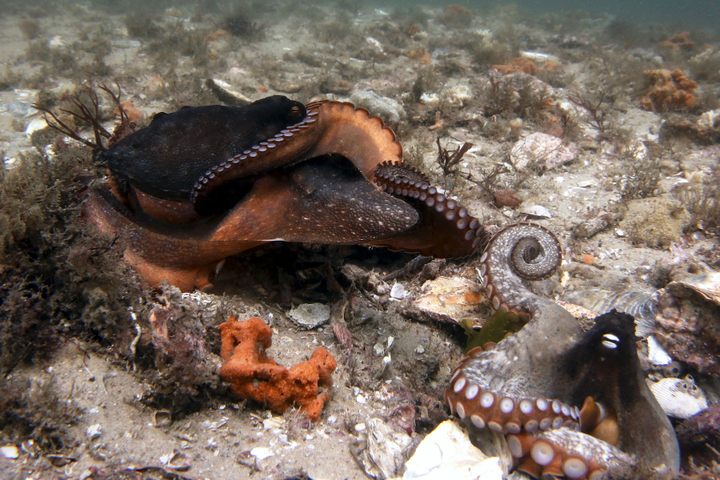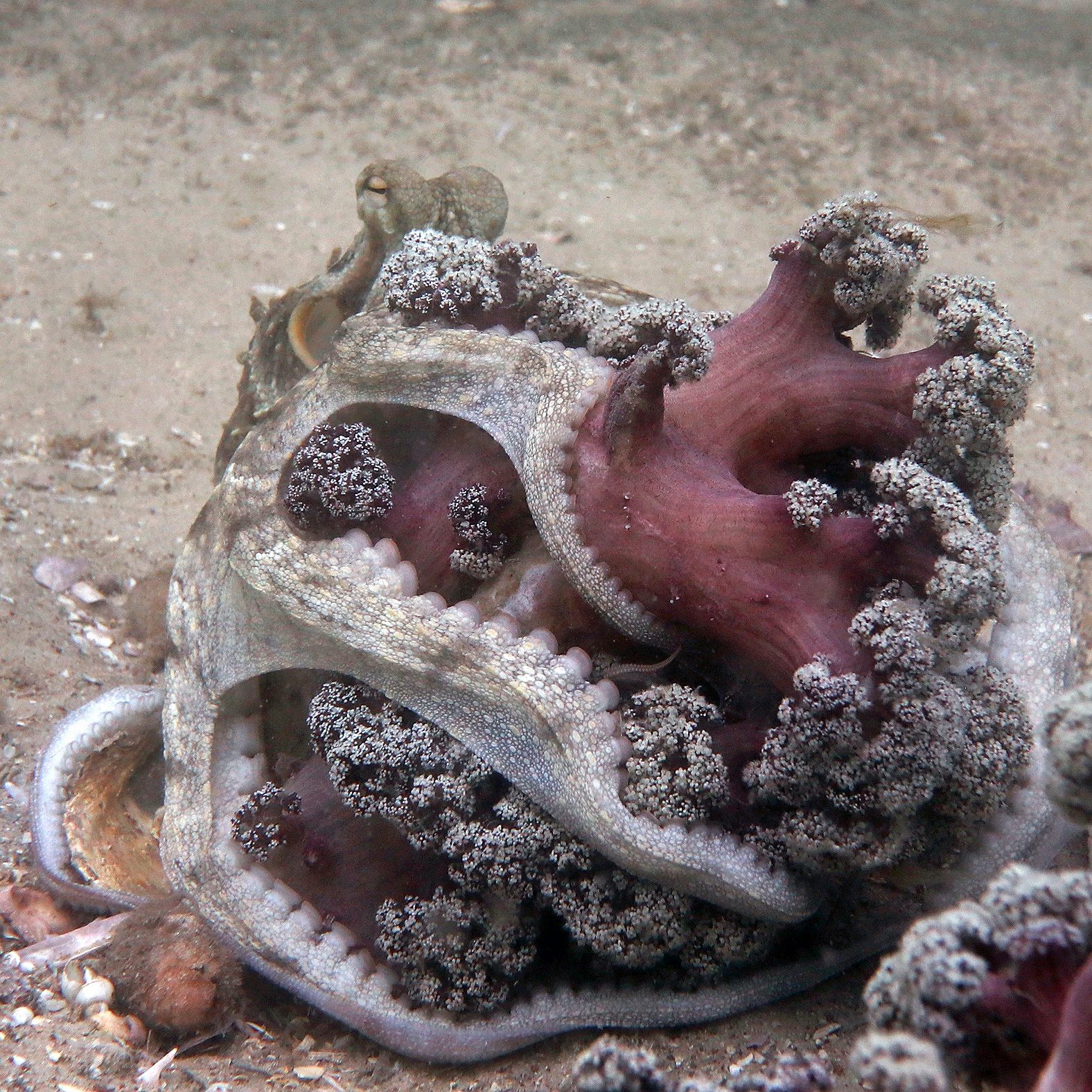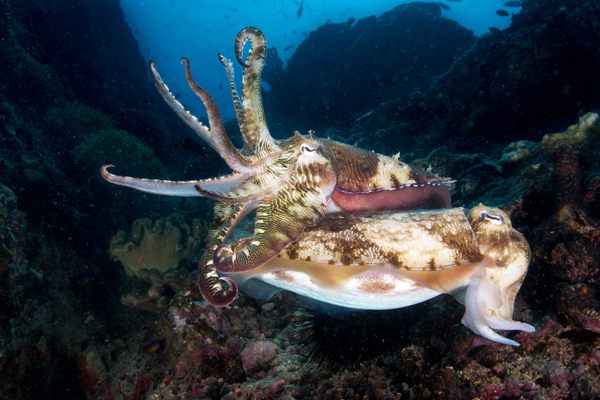
When Usually Solitary Octopuses Get Together, Odd Things Happen
Observations from Octopolis and Octlantis.
This story is excerpted and adapted from Peter Godfrey-Smith’s Metazoa: Animal Life and the Birth of the Mind, published in November 2020 by Farrar, Straus and Giroux.
Wandering on scuba across a sandy plain populated by scallops during an exploratory dive in 2008, off the east coast of Australia, diver Matt Lawrence came across a small area where thousands of empty scallop shells were piled up and about a dozen octopuses were living. Octopuses have generally seemed very solitary animals, but this site showed that octopuses can, in some circumstances, live in rather close quarters. Lawrence and I, as a diver and philosopher of science, have studied this site, which we called “Octopolis,” extensively over the years, and witnessed a range of unusual behaviors among these octopuses, from evicting others to passing touches to ongoing ruckuses of den-eviction, jostling, and turf-wrangling. This might be a situation where animals of a mostly solitary species have come to live in unusual densities and are learning, individually, how to get along. Alternatively, more sociality might exist in octopus lives, in this species and some others, than has been recognized.
In 2017, two other divers, Marty Hing and Kylie Brown, exploring the same general area, discovered a second site, now christened “Octlantis.”
Like Octopolis, it was a setting with much food in the form of scallops, much danger from a range of predators, and few den options outside of a couple of isolated rocks poking up from the seafloor. At both sites, octopuses bring in scallops and leave the shells, which makes more places for dens. The numbers at Octlantis are similar to those at Octopolis; the most I have seen there is 14, spread across three subregions, all in a pretty small area.

Both sites generate more behavior than you usually see with octopuses—more interaction, more activity. We just watch the octopuses do what they do, and years of observation have given us a growing sense of their range of behaviors. As I watch, I am always wondering about those relationships between central brain control and their neuron-packed arms.
A lot of what we see is coordinated, whole-body behavior. The animals shift between different kinds of motion. In jet propulsion, the arms are brought together and the animal becomes a slender missile. When crawling, the arms go everywhere at once. Some behaviors are packaged together into what appear to be social displays. An aggressive animal will often stand very tall with arms spread, and with the mantle (the large rear part of the body) pointing straight upward. This is combined with intense dark colors—an octopus can change its entire color in less than a second. It makes the animal look as large as possible, and genuinely ominous. We call this the Nosferatu display.
A particularly intriguing behavior is throwing. Octopuses sometimes gather material in their arms, and then either carry and release it, or sometimes throw it out in a concerted, occasionally spectacular, way. The arms are used to first collect some combination of shells, seaweed, and silt. As this material is held, the animal’s jet propulsion device is brought under the arm web, and a sudden jet of water propels everything out. These debris-throws can go for several body lengths. Often the material thrown hits another octopus.

My collaborator, marine biologist David Scheel of Alaska Pacific University, was the first to note a possible social role for this behavior. Are the octopuses aiming these throws at others? Is it a form of mild aggression? It is very hard to tell, as this requires working out what the octopus intends to do. That is difficult enough in the case of animals very close to ourselves, and extremely so with an octopus. Scheel and I have spent a lot of time trying to work out how to interpret octopus intentions, an activity fraught both with scientific and philosophical puzzles.
Most debris throws are probably part of den-building and den-cleaning. Octopuses spend a lot of time clearing rubbish that accumulates in their dens, and throws are part of this. If an octopus is doing this while paying some attention to another nearby octopus, as they often are, then it can be expected that some throws would inadvertently result in hits. Females seem to throw more than males, which is intriguing, but females also tend to build and maintain better dens than males. This makes sense, as females eventually have to brood eggs.
However, females quite often throw at males who are pestering them. They also throw at other females who seem to be too much “in their space.” If you are hanging out with an octopus near its den while diving and you start to bother it—perhaps by interfering, perhaps just by being too long in its space—you may feel a brisk jet of water propelled toward you. One can see a path where an octopus throws debris incidentally, hits another octopus by chance, and notices the effects. If the throw is big, a pestering male will back off, startled. All this may well be an instance of the kind of low-level aggression we’ve seen at both sites. But with octopuses, it’s always hard to tell what is going on.
At Octlantis, I saw an interesting use of a found object. A small octopus was staring at one of our unmanned cameras from its den, and then went off camera and returned with a piece of dead sponge. It arranged this on the top of the den, as something between a roof and a helmet, and huddled beneath it, looking out. I am not sure that the little octopus was bothered by the camera, and wanted a barrier against its presence, but it did look that way.
Octopuses show all these well-organized, whole-body behaviors, but there’s another side to their actions: ongoing exploration by the arms. A crawling octopus that’s not in a hurry often allows its arms to roam a bit in many directions. When an octopus is sitting fairly quietly, a few arms often range out, like little eels, with their delicate, questioning tips. But this behavior is less apparent at Octopolis and Octlantis, perhaps because these octopuses are less relaxed. I think there is a kind of heightened attention at Octopolis and Octlantis, due to the social complexity, and ever-present question of sex.
A picture suggested by all this is that the octopus body is subject to a kind of mixed control. The body can be partially commanded and steered by the central brain, but the body also has parts that engage in their own ongoing exploration, reacting individually to their surroundings. Centrally coordinated actions can pass over to the exploratory tendencies of the arms. Watching octopuses sometimes results in a series of gestalt shifts, between seeing the animal as a whole whose each arm is a tool, and seeing an arm wander about, apparently in response to what it is sensing itself.
People often now talk about octopuses as “smart,” and in some ways they are. But that is not the term that comes readily to my mind. Octopuses are behaviorally complex, and I think they are also sensitive. I think they experience their lives in a rich way. The word “smart” points toward a particular way of being, however. It suggests that we interpret their behavioral complexity in a rather intellectualized manner. Octopuses are exploratory animals who direct the complexity of their bodies on whatever confronts them. They fiddle about and try things and turn the problem over and over—physically, not mentally. Octopuses have an extraordinary sensorium and an anarchic bodily embrace of novelty, but they are not, for the most part, ruminative and “clever” sorts of animals.

But they do have a little of this clever side—some famous incidents where octopuses have escaped mysteriously from aquarium tanks might involve something close to planning, and their employment of objects such as shells and coconuts for protection is a kind of tool use. This use of objects seems to have an improvised, opportunistic look about it in some cases, including the case of the one at Octopolis that retrieved a sponge to hide from our camera. Those behaviors suggest a sort of mental as well as physical exploration. This appearance might be misleading—perhaps all the uses of shells, coconuts, sponges, and the like are well-established behaviors that evolution has shaped as a response to predators. But there, along with one other context, is where I’d be looking for signs of “cleverness.”
The other context is more social. Octopuses show a surprising awareness of what other agents, including people, are up to. They often make their moves to escape when you are not looking at them. The same sort of thing is true with cuttlefish. Bret Grasse, who manages octopuses and other cephalopods at the Woods Hole Marine Biological Laboratory in Massachusetts, has spent more time around these animals than just about anyone. Grasse has the impression that they are often very aware of what he is doing. They squirt water at him sometimes, but wait until he is not looking. Once he was squirted and turned to see a bunch of innocent cuttlefish near the bottom of their tank. He then used his phone’s camera to watch them while his back was turned.

Several came up to the surface and squirted him again.
Something else I like about octopuses—not something related to smartness, just something good—is the fact that individuals of the same species differ so much, even when performing fairly basic behaviors. They show many differences in personal style, for want of a better word. At another site, I came across a large octopus in his den. I didn’t try to disturb him, but he hauled himself out as I watched, and we set off across the landscape.
He kicked one octopus out of its den and mated with another. All the time during this, he moved in an unusual, stylized-looking way, producing flattened blade-like shapes in his arms, winding his arms over his head and backward for no apparent reason, coiling an arm into a wheel. I had not seen an octopus handle its arms like this before, and there seemed no particular reason for it. It just seemed an eccentricity, a quirk, like the many individual quirks in den-building. Everything he did was writ large.























Follow us on Twitter to get the latest on the world's hidden wonders.
Like us on Facebook to get the latest on the world's hidden wonders.
Follow us on Twitter Like us on Facebook